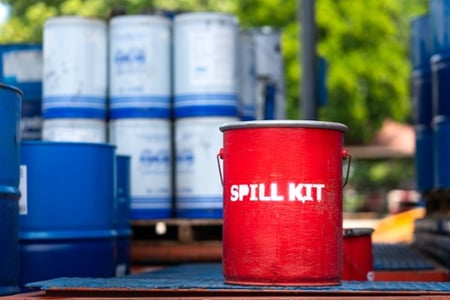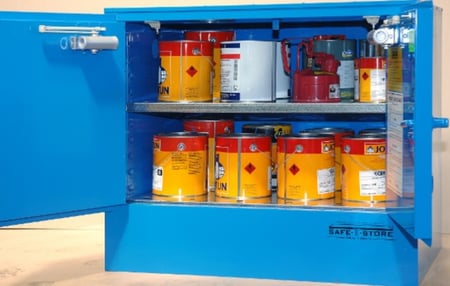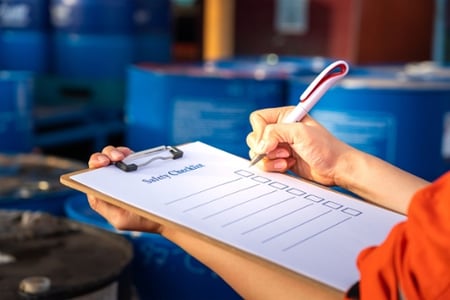If you’re carrying any type or quantity of dangerous goods in your business, you have a responsibility to meet the requirements of the Work Health and Safety Regulations. Keeping your staff safe while they’re at work, and protecting your business, community and environment, is a vital, yet often challenging part of running a business. In this post, we’re breaking down the essential responsibilities of dangerous goods management. This is general information for anyone who owns or operates an enterprise in Australia. We hope this information can help you simplify your list of responsibilities, so you can stay on top of your legal obligations and ensure safety in your workplace.
Let’s get started by looking at the general health and safety responsibilities for organisations that carry hazardous chemicals.
WHS and Your Workplace
Whether you’re running an electrical business from your van or a major global corporation, your operations fall under the jurisdiction of the WHS laws in your particular state or territory.
In regard to general workplace management, this may include maintaining a safe working environment, providing instruction, training and information to staff, the provision of first aid and PPE, and the development and implementation of emergency plans.

There are a broad range of general duties that workplaces must uphold under WHS laws.
Under WHS Regulations, you have a duty to reduce and control any chemical hazards in your operations. Chapter 7 of the Model Regulations outlines the responsibilities that relate to organisations who manufacture, import or carry hazardous chemicals.
IMPORTANT: The Model WHS Regulations (2021) provide a basis for WHS laws across the country. However, the WHS authority in your state or territory will be responsible for adopting, implementing and upholding the WHS laws. The model WHS laws have been implemented in all Australian jurisdictions, apart from Victoria.
Controlling Risks Associated With Hazardous Chemicals
There are a multitude of daily, monthly and annual duties that need to be performed in businesses carrying hazardous chemicals.

When a business carries hazardous chemicals, they’re obligated to control the risks associated with their particular chemical products.
Controlling risks, and the ongoing maintenance of these controls, is the responsibility of any person operating an Australian business. And while the scope of this is broad, there are several key areas that you can start focusing on now to actively reduce the likelihood and impact of an incident involving hazardous chemicals.
As an employer, you have general duties under WHS laws to ensure the safety of:
- Yourself
- Workers, including staff, contractors and volunteers
- Other people in the workplace, including visitors, customers, clients
These duties include:
- providing and maintaining a work environment that does not pose a risk to health and safety
- providing adequate, accessible facilities for the welfare of workers to carry out their work; and
- monitoring the health of workers, as well as the working environment, to prevent the occurrence of illness or injury
Your duties include the control of risks, as well as the maintenance of the workplace and facilities. You also have an obligation to consult with workers on health and safety matters, and provide information, instruction, training and supervision to improve the welfare of staff.
Daily Duties
There are many daily duties that can assist with the successful management of dangerous goods and hazardous chemicals in the workplace.
These daily duties may include:
- Reviewing stocks of chemicals
- Ordering chemicals
- Handling chemical deliveries by placing into compliant storage immediately
- Monitoring workplace for hazards, such as leaks or spills
- Wiping down of chemical containers after use
- Checking chemical labels are correct and in place
- Locking of chemical cabinets or stores after use
- Monitoring of vapours or unusual chemical smells
- Inspecting and cleaning out chemical bunds
- Keeping chemical handling equipment clean and decontaminated
- Putting handling equipment back in designated location
- Ensuring PPE in maintained and decontaminated after use
- Putting protective clothing back in PPE storage cabinet after its used
Weekly Duties
Your weekly duties should include scheduled inspections of your controls, as well as housekeeping duties. By maintaining your controls on a regular schedule, you’re adhering to your duties under WHS laws and ensuring that your controls are working as they should.

Keeping your storage areas organised, clean and free from chemical residue in an essential part of maintaining compliance.
Some suggested weekly duties may include:
- Inspecting all chemical storage and handling equipment
- Reporting on your weekly inspections
- Implementing any corrective actions, if required
- Inspecting chemical bottles, drums, containers etc. for damage, splits or leaks
- Ensuring stores are only carrying the correct chemical products
- Checking that each product’s SDS is visible and accessible
- Ensuring the hazardous chemicals register is up-to-date
- Inspecting the installation of cabinets and stores to maintain compliance
- Cleaning out all bunds and wiping out all storage facilities
- Checking that dangerous goods and hazard signage is in place
- Inspecting the site so that no further hazards have been noticed
- Ensuring all chemical handling and storage areas are free from rubbish, dust and any discarded packaging
- Check all ventilation systems and ensure airborne contaminants are at safe levels
- Inspecting first aid kits and spill kits
- Ensuring there are no incompatibility hazards with other chemicals
- Staff inductions and training, when required
- Ordering of PPE, chemical handling and storage equipment, when required
Monthly Duties
Your monthly duties may include more timely tasks, such as conducting risk assessments, reviewing your control measures, or ordering dangerous goods storage or handling equipment. You may also choose to implement a monthly meeting or refresher training course, so staff can keep up to date with any changes in the work practices or chemicals kept onsite.
Suggestions may include:
- Monthly staff meetings to consult with workers on health and safety issues
- Reviews of controls to ensure they stay current and effective
- Review of the chemical ordering for the month, with a focus on maintaining a minimum stock to decrease risk
- Assessing of reported incidents such as spillage, workplace injuries and accidents
- Review of supervision practices
- Scheduled maintenance on all equipment and machinery, if required
- Refresher training courses for staff who handle the chemicals
- Risk assessments, when required
- Budgeting for chemical storage equipment, handling equipment and PPE
- Inspection of all firefighting equipment
- Inspection of emergency decontamination facilities
- Restocking of spill kits
- Review of emergency plans and responses
What Resources Can Assist With DG Management?
In addition to having a solid understanding of the WHS laws that relate to your state or territory, we strongly suggest familiarising yourself with the Australian Standards.
The Standards offer detailed guidance for each class of dangerous goods, with specific instructions on how to handle and store these substances.
The Australian Standards, just like WHS laws, can be updated, so it’s important to access the latest copy for the most relevant requirements.

You may access a range of resources to assist with your management of dangerous goods.
There are also multiple codes of practice, issued by Safe Work Australia, that can assist with general chemical compliance in the workplace. Codes of practice, while not law, are admissible in court proceedings. They offer excellent advice on how to manage hazards and risks, however, it’s your responsibility to consider all the risks in your workplace.
Some helpful codes of practice include:
- Preparation of safety data sheets for hazardous chemicals
- Spray painting and powder coating
- Managing risks of hazardous chemicals in the workplace
This can be best achieved by conducting regular risk assessments. If your team doesn’t have the knowledge or experience to conduct an inhouse risk assessment, speak with a Dangerous Goods Consultant who can advise on best practice for your chemical handling and storage areas.
Keeping Workplaces Compliant
To learn more about dangerous goods management in the workplace, it’s important that you report and investigate any incident that involves hazardous chemicals. This allows your organisation to understand the factors that led to the incident, so you can take the appropriate corrective actions. This process ensures that the existing chemical risk is properly controlled, so you move forward safely with your daily operations.
To find out more about this topic, why not access our free eBook? Investing Incidents Involving Hazardous Chemicals provides details on how to successfully investigate incidents such as chemical spillage, so you can work towards improving the health and safety of your site. Grab your copy of our guide today by clicking the link below.
Joining the team as a Dangerous Goods Storage Consultant, Melissa Hampton became Storemasta's Marketing Manager in late 2021. With extensive knowledge and experience in chemical compliance, Melissa is responsible for leading the Marketing team and helping shape their marketing strategy. In her spare time, you can find Melissa hiking, swimming and enjoying the great outdoors in beautiful north-west Tasmania.
